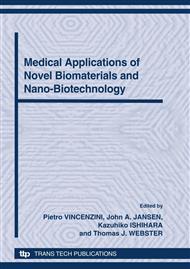p.190
p.195
p.207
p.214
p.224
p.229
p.235
p.240
p.247
Nano-Scale Evaluation of Surface Morphology Before and After Environmental Exposure In Vitro of an Advanced Alumina/Zirconia Composite for Arthroplastic Applications
Abstract:
In view of the imminent release on the Japanese market of hip prostheses made of an advanced alumina/zirconia, we performed morphologic and spectroscopic assessments of their surfaces with high spatial resolution. Femoral heads were characterized to a degree of statistical accuracy in the as-received state and after long-term exposures in vapor-moist environment. Surface and sub-surface screening was made by atomic force microscopy (AFM) and by confocal Raman spectroscopy, respectively. AFM scanning was systematically repeated with nanometer resolution on portions of surface as large as several tens of micrometers, randomly selected on the head surface, while in-depth scanning by the Raman probe allowed non-destructive analysis of phase structure in the sub-surface slab of material. Polymorphic transformation in zirconia was confined to the first few micrometers below the surface and involved no significant increase in surface roughness even after long-term environmental exposure. Surface roughness lied in a range <10 nm after environmental exposures up to 100 h, corresponding to an exposure time in vivo of several human lifetimes (i.e., according to experimentally derived thermal activation energy).
Info:
Periodical:
Pages:
224-228
Citation:
Online since:
October 2010
Authors:
Price:
Сopyright:
© 2010 Trans Tech Publications Ltd. All Rights Reserved
Share:
Citation:


